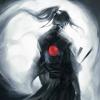Ok, I think we have our answer now.
This from Togishi David Hofhine and photo of a Mantetsu that he polished in 2017.
"When finely polished the Koa Isshin Mantetsu has a nashiji-hada. This is a surface that looks something like the flesh of a sliced open pear. In this case this is a texture caused by the crystalline structure in the metal and not by a folding pattern. Some folded blades exhibit a similar pattern if the skin steel has been folded so many times that the weld lines all blend together. The hamon is primarily nioi deki suguha, but with some ko-nie along the top. No larger nie crystals. It has been reported that the Koa Isshin blade may have been tempered in water rather than oil. The composite construction of the blade allowed for the more traditional method of tempering. There is also a faint bo-utsuri about 1/4" above the hamon, visible in parts along the length of the blade. Unfortunately all of these subtle features are nearly impossible to photograph using the equipment that I have."


